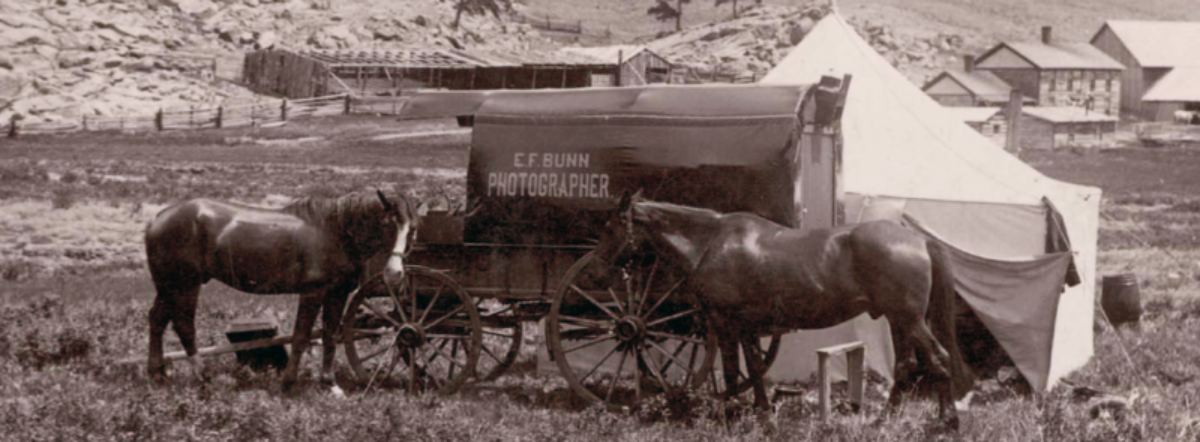Joseph Gonder Hiestand was born in Lancaster County, Pennsylvania, on August 15, 1860, to John Valentine Hiestand and Eve Ann Gonder Hiestand. His father worked as a coachmaker and later served as a clerk in Washington, D.C. While in Washington, Joseph visited the Smithsonian Institution and developed an interest in mineralogy. He trained at Philadelphia’s Academy of Arts and Sciences and soon began assembling his own collection of minerals.
In the early 1880s, Hiestand settled in Manitou Springs, Colorado, a tourist town renowned for its healing mineral springs, particularly the Ute Iron Springs. Hiestand opened the Manitou Scientific Museum in the pavilion of the Ute Iron Springs to showcase his collection of rare minerals–one of the largest in the West. His museum, a 25 x 40-foot room, was elegantly furnished and lined with display cases for mineral specimens, jewelry, and curiosities. The space was adorned with pictures as well as taxidermied animals and birds. Hiestand hired four men to work at the museum. A complete range of cigars, candy, and lemonade made from the iron-rich water was available for sale.


In the spring of 1887, Hiestand leased the Ute Iron Springs, one of Manitou’s most popular tourist attractions. On March 28, 1889, Hiestand married Aline Zerelda Garrison Adams in Colorado Springs. In addition to running the springs as a concession, Hiestand opened a photographic gallery at the Iron Spring Pavilion in July 1890. He became one of the best-known businessmen in Manitou Springs by managing both companies. The gallery was under the day-to-day oversight of George E. Mellen, a photographer from Colorado Springs who was a former employee of William Henry Jackson, while photographer Lewis Imes oversaw portrait work.
Just inside the gallery, patrons entered a reception room filled with photographs from around the world. Off the reception room was the operating room with floors of oiled Georgia pine and a skylight with panes of ground glass that let in a soft, mellow light. The studio contained many backgrounds and screens for portrait work. Another room was devoted to making bromide enlargements and lantern slides. A short stairway led to the flat roof of the building where large-size work could be printed by the sun’s rays. Once developed, the prints were placed in a toning bath and then washed. A special set-up was devoted to panoramic work.
When the 8.9-mile Manitou & Pikes Peak Railway began transporting passengers up Pikes Peak via steam-powered locomotives, Hiestand became the line’s official photographer. He took group portraits of the passengers at the summit and then sped down the rails on a go-devil–a single-person vehicle that quickly descended the slope. There, he developed the negatives and printed the photographs to sell to the passengers as they disembarked from the train.


Ute Iron Springs was a popular tourist destination attracting well-heeled visitors from across the United States. The families of Mildred Mary Myers and John S. Cravens came to Manitou Springs from Kansas City, Missouri in the summer of 1890, where their friendship blossomed. Miss Myers was the daughter of George S. Myers, a millionaire tobacconist. John Craven was a graduate of Yale University. They married on December 28, 1893, in Missouri.
Hiestand’s photographs were published in several souvenir booklets of Colorado Springs, and the Pikes Peak region. After nearly two decades of leasing the Ute Iron Springs, Hiestand purchased the property for $20,000. Based on his visit to the famous mineral baths in Saratoga, New York, he planned to invest $5,000 in improvements, including enlarging the pavilion and adding a hard-wood dancing floor.
In 1906, Hiestand was sued for $50,000 for breach of promise by Ida Clarke, a young woman who claimed she did not know Hiestand was married when she engaged in a romantic relationship with him. She attested that Hiestand promised to marry her. The sensational trial revealed that the young woman was under the age of consent when the couple took a prenuptial honeymoon. They had frequently registered at a Denver hotel as husband and wife. She lived at his home in Manitou for two years while Hiestand’s wife and three daughters were living in New York. The jury was unable to agree and was dismissed. Rather than go through another trial, the parties settled out of court. Miss Clarke’s settlement was disclosed as $16,000.
Hiestand died on January 1, 1916, when a gun he was cleaning discharged. The bullet passed through his right side and lodged in the wall behind him. Whether it was a suicide or an accident was never fully determined. He was buried at the Middletown Cemetery in Middletown, Pennsylvania.
Special thanks to Beverly W. Brannan, whose thoughtful feedback helped shape this piece. Dave Wendel, Digital Archives Specialist, at the Penrose Library — Regional History & Genealogy, Pikes Peak Library District provided valuable reference assistance.



